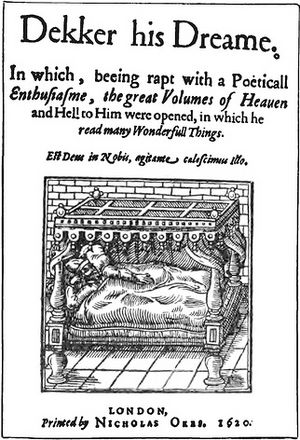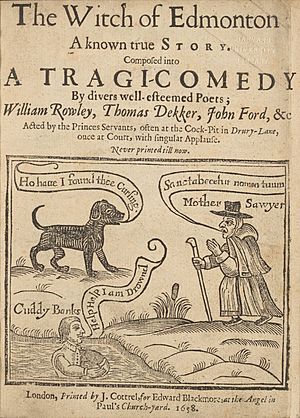Thomas Dekker (writer) facts for kids
Quick facts for kids
Thomas Dekker
|
|
|---|---|

Thomas Dekker lying in bed, from the title page of Dekker his Dreame (1620)
|
|
| Born | c. 1572 London, England
|
| Died | 25 August 1632 (aged 60) London, England
|
| Occupation | Writer |
Thomas Dekker (born around 1572 – died August 25, 1632) was an English writer. He wrote plays for the theater and also many short books called pamphlets. He was a very busy and creative writer. His career lasted for many years. He worked with many famous writers of his time.
Contents
Early Life of Thomas Dekker
We do not know much about Thomas Dekker's early life. We think he was born in London around 1572. This is based on things he wrote in his pamphlets. His last name, Dekker, might mean his family came from the Dutch area. He knew Latin, which suggests he went to a good school.
Dekker's Writing Career
Dekker started writing for the theater in the mid-1590s. He worked on many plays. One of his earliest known works is Sir Thomas More. He also wrote plays for a theater group called the Admiral's Men. This group was led by Philip Henslowe.
Between 1598 and 1602, Dekker helped write about 40 plays for Henslowe. He often worked with other writers. Some of his partners included Ben Jonson and John Marston. These collaborations sometimes led to arguments between writers. This period was known as the War of the Theatres.
However, Dekker wrote one of his most famous plays all by himself. It was called The Shoemaker's Holiday (1599). This play is a lively comedy about everyday life in London. It shows the city through the eyes of someone who loves adventure and romance.
After 1602, Dekker started writing more pamphlets. He also continued to write plays. He worked with both older writers and younger ones. These included John Day, John Webster, John Ford, and Philip Massinger.
Later Years and Death
In his later years, Dekker kept writing plays. He also went back to writing pamphlets. He updated some of his older works. He also wrote new ones, like a new introduction for his popular book The Bellman of London.
Thomas Dekker stopped publishing new work after 1632. He is believed to be the "Thomas Dekker, householder" who was buried in Clerkenwell that year. He was around 60 years old when he died.
Dekker's Works
Plays for the Stage
When Dekker started writing plays, some older famous writers were still alive. By the time he died, a new generation of writers had begun. Like many writers, he changed his style to fit new tastes. Most of his plays that we still have are comedies or tragicomedies. These plays mix funny parts with serious ones.
Sadly, many of Dekker's plays are now lost. He did not have a strong connection to just one theater company. This might be why many of his play scripts were not saved or published.
We know about Dekker's early plays from Philip Henslowe's diary. In 1598, Dekker's name first appeared for a play called "fayeton." He also worked on plays like The Mad Man's Morris and Hannibal and Hermes. He often worked with other writers on these projects.
In 1599, he wrote plays about Troilus and Cressida. He also worked on Page of Plymouth. That same year, he created three plays that are still known today. This was when he wrote The Shoemaker's Holiday. This play is about the daily lives of regular people in London. It even includes a famous poem called The Merry Month of May.
After 1602, Dekker wrote fewer plays. He spent more time writing pamphlets. During his time in prison, Dekker did not write plays. After he was released, he worked with Day on plays like Guy of Warwick (1620). He also wrote with Ford on The Sun's Darling (1624).
Dekker's plays in the 1620s were often performed at large outdoor theaters. These included the Red Bull theater. These theaters were popular with younger audiences, like apprentices. Dekker's plays were perfect for them. They had lots of action and were often very funny. They also showed the positive spirit of plays from the earlier Elizabethan era.
Dekker's Prose Writings
Dekker also wrote many lively pamphlets. These were short books or essays. He wrote them throughout his career. They covered many different topics and styles.
Dekker started writing pamphlets around 1603. This was perhaps when the plague closed the theaters. His first pamphlet was The Wonderfull Yeare. It was like a news report about the death of Queen Elizabeth I. It also covered the start of King James I's rule. And it talked about the 1603 plague. This pamphlet was very popular. It led him to write two more about the plague.
After 1608, Dekker wrote his most popular pamphlets. These were called "cony-catching" pamphlets. They described the tricks and scams used by thieves and con artists. They even included some of the secret language used by thieves. Dekker often updated and re-released these pamphlets. Some titles include The Belman of London and Lanthorne and Candle-light.
Other pamphlets were like news articles. They gave a clear picture of London life during King James's time. The Guls Horne-Booke (1609) described the lives of young, fashionable men in the city. It also gave helpful details about how people behaved in London theaters.
Dekker's pamphlets were often written quickly. But the best ones are still fun to read today. They also give us valuable details about daily life in the 1600s.
One of Dekker's poems, "Golden Slumbers," became part of a modern popular song. Paul McCartney used some of its lyrics in the Beatles' 1969 song "Golden Slumbers".
See also
 In Spanish: Thomas Dekker (escritor) para niños
In Spanish: Thomas Dekker (escritor) para niños


